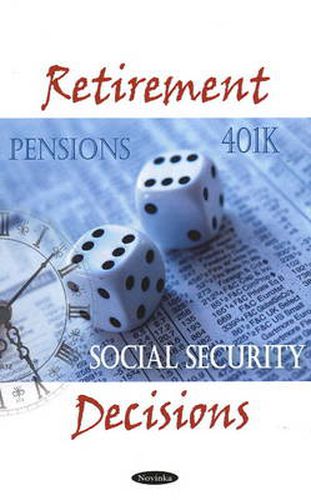Readings Newsletter
Become a Readings Member to make your shopping experience even easier.
Sign in or sign up for free!
You’re not far away from qualifying for FREE standard shipping within Australia
You’ve qualified for FREE standard shipping within Australia
The cart is loading…






The first wave of the 78 million member baby boom generation is now reaching retirement age. The number of people age 62, the earliest age of eligibility for Social Security retired worker benefits, is expected to be 21 percent higher in 2009 than in 2008. In addition, by 2030, the number of workers supporting each retiree is projected to be 2.2, down from 3.3 in 2006. This demographic shift poses challenges to the economy, federal tax revenues, the nation’s old-age programs, and individuals’ financial security in retirement. For those who are able to work longer, later retirement can strengthen the economy and also retiree incomes by postponing the time at which people will start drawing retirement benefits rather than working. A wide range of factors including the features of employers’ benefit plans, personal finances, social norms, health, and individual attitudes influence workers’ decisions about when to retire. Federal policies may also play a role: these include Social Security, Medicare, and tax policies related to certain private retiree health and defined benefit (DB) and defined contribution (DC) pension plans.1 Identifying both the incentives posed by these policies and the extent to which workers respond to them can help to inform policy makers as they consider ways to address the demographic challenges facing the nation. To determine the extent to which federal policiesdirectly and indirectly-pose incentives and are influencing individuals’ decisions about the age at which they retire, the authors have pursued the following questions: (1) What incentives do federal policies provide about when to retire? (2) What are the recent retirement patterns, and is there evidence that recent changes in Social Security requirements have resulted in later retirements? (3) Is there evidence that tax-favored private retiree health insurance and pension benefits have influenced when people retire? This is a revised and excerpted version.
$9.00 standard shipping within Australia
FREE standard shipping within Australia for orders over $100.00
Express & International shipping calculated at checkout
The first wave of the 78 million member baby boom generation is now reaching retirement age. The number of people age 62, the earliest age of eligibility for Social Security retired worker benefits, is expected to be 21 percent higher in 2009 than in 2008. In addition, by 2030, the number of workers supporting each retiree is projected to be 2.2, down from 3.3 in 2006. This demographic shift poses challenges to the economy, federal tax revenues, the nation’s old-age programs, and individuals’ financial security in retirement. For those who are able to work longer, later retirement can strengthen the economy and also retiree incomes by postponing the time at which people will start drawing retirement benefits rather than working. A wide range of factors including the features of employers’ benefit plans, personal finances, social norms, health, and individual attitudes influence workers’ decisions about when to retire. Federal policies may also play a role: these include Social Security, Medicare, and tax policies related to certain private retiree health and defined benefit (DB) and defined contribution (DC) pension plans.1 Identifying both the incentives posed by these policies and the extent to which workers respond to them can help to inform policy makers as they consider ways to address the demographic challenges facing the nation. To determine the extent to which federal policiesdirectly and indirectly-pose incentives and are influencing individuals’ decisions about the age at which they retire, the authors have pursued the following questions: (1) What incentives do federal policies provide about when to retire? (2) What are the recent retirement patterns, and is there evidence that recent changes in Social Security requirements have resulted in later retirements? (3) Is there evidence that tax-favored private retiree health insurance and pension benefits have influenced when people retire? This is a revised and excerpted version.